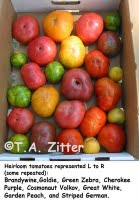(Submitted by “Cassandra” from Cassanadra Does Tokyo)
Considering our location high on the ridgeline above the steep slopes of deflation on one side and the inflationary abyss n the other, and despite our slip (in the last two weeks) seemingly towards deflation, I thought it apt to offer up some non-traditional stores of value given the teetering banking system, near vertical ascent of commodities, and the still highly departed real estate indices as multiples of median incomes, all which cause consternation when it comes to preserving capital (at least for the contrarian). Of course, everyone is encouraged to share their own.
 Anyone who’s ever happened upon any episode of Antiques Roadshow is familiar with the increasing value of things vintage. Factory Farming and GMO crops that require pesticide and ever-more expensive nitrates could result in nice premiums to the colourful but gnarly-looking heirloom varieties (pictured left). And in the worst case, should things not work out as planned, they would make for delicious eating!
Anyone who’s ever happened upon any episode of Antiques Roadshow is familiar with the increasing value of things vintage. Factory Farming and GMO crops that require pesticide and ever-more expensive nitrates could result in nice premiums to the colourful but gnarly-looking heirloom varieties (pictured left). And in the worst case, should things not work out as planned, they would make for delicious eating!
 Garden sculpture too provides a fascinating utilitarian place to keep your money both safe and close by – especially if its a veritable work of the late Alexander Calder. Indeed, too big to steal, it simply sits, making itself wondrously beautiful to all who gaze upon it, and best of all, appreciates – even on weekends! Fortunately, such behemoths don’t fit on Ken Griffin’s roof terrace, so their values remain tame by comparison to smaller, more portable impressionist wall-hangings.
Garden sculpture too provides a fascinating utilitarian place to keep your money both safe and close by – especially if its a veritable work of the late Alexander Calder. Indeed, too big to steal, it simply sits, making itself wondrously beautiful to all who gaze upon it, and best of all, appreciates – even on weekends! Fortunately, such behemoths don’t fit on Ken Griffin’s roof terrace, so their values remain tame by comparison to smaller, more portable impressionist wall-hangings.
 The Dutch have always been sober-minded despite their paradoxical tolerance of cannabis, evidenced here by their practical love-affair with the Windmill. Considering how long these beauties have been around, they must have ultra-long depreciation schedules that would warm the heart of even the most parsimonious purchasers.
The Dutch have always been sober-minded despite their paradoxical tolerance of cannabis, evidenced here by their practical love-affair with the Windmill. Considering how long these beauties have been around, they must have ultra-long depreciation schedules that would warm the heart of even the most parsimonious purchasers.
 War, depressions, floods have not deterred the thronging masses of football fans and the popular spirit of athletic competition. The problem is that professional sports has been gripped by a “Location Location Location”-like mantra that has lead well-heeled psychic-income-seeking egos to pay top-dollar (and pound!) for trophies that will likely hemorrhage cash when the going gets errr ummmm tough – at least until the proverbial screws are turned in earnest. Second-tier sports clubs (like Millwall for example, or even Hamilton Academical) share the same consumer non-durable demand characteristics for a fraction of the price of, say, Chelsky. And Millwall has the added benefit of providing Vinnie Jones-like muscle for less-than-salubrious “other pursuits” if things do, in fact, get even tougher-than-expected.
War, depressions, floods have not deterred the thronging masses of football fans and the popular spirit of athletic competition. The problem is that professional sports has been gripped by a “Location Location Location”-like mantra that has lead well-heeled psychic-income-seeking egos to pay top-dollar (and pound!) for trophies that will likely hemorrhage cash when the going gets errr ummmm tough – at least until the proverbial screws are turned in earnest. Second-tier sports clubs (like Millwall for example, or even Hamilton Academical) share the same consumer non-durable demand characteristics for a fraction of the price of, say, Chelsky. And Millwall has the added benefit of providing Vinnie Jones-like muscle for less-than-salubrious “other pursuits” if things do, in fact, get even tougher-than-expected.
 Little could be more basic than transport. So if oil has “peaked” and cold nuclear fusion, and the BTF Flux-Capacitor remain far-off pipe-dreams, what could be better than owning your own existing commuter rail service?!? Japan remains one of the few places where private rail service demonstrably works AND throws off reasonable cash-flow which after almost two decades of ratings compression are almost attractive. No NIMBY complaints as the lines are laid and more or less paid for. OK so Nagoya Rail’s (pictured here) dated commuter cars need capex for sprucing up, but the earnings yields are reasonsably attractive (compared to JGBs) and there is reputed to be large under-valued land holdings still on the books if ever asset prices in Japan do revive.
Little could be more basic than transport. So if oil has “peaked” and cold nuclear fusion, and the BTF Flux-Capacitor remain far-off pipe-dreams, what could be better than owning your own existing commuter rail service?!? Japan remains one of the few places where private rail service demonstrably works AND throws off reasonable cash-flow which after almost two decades of ratings compression are almost attractive. No NIMBY complaints as the lines are laid and more or less paid for. OK so Nagoya Rail’s (pictured here) dated commuter cars need capex for sprucing up, but the earnings yields are reasonsably attractive (compared to JGBs) and there is reputed to be large under-valued land holdings still on the books if ever asset prices in Japan do revive.
 One of the greatest stores of value, amusingly, has been paper. Not newsprint, or the ordinary kind, but the type bearing the likeness of the legendary Honus Wagner. The T207 has continued appreciate at quasi-exponential rates, long after my cousin paid for his Harvard education with the unlikely (at the time) and short-sighted (in retrospect) sale for a sum of five-digits. Compared to current values, he might as well have given it away…
One of the greatest stores of value, amusingly, has been paper. Not newsprint, or the ordinary kind, but the type bearing the likeness of the legendary Honus Wagner. The T207 has continued appreciate at quasi-exponential rates, long after my cousin paid for his Harvard education with the unlikely (at the time) and short-sighted (in retrospect) sale for a sum of five-digits. Compared to current values, he might as well have given it away…
 Diamond-encrusted skulls, while not MY my metaphorical cup of tea, apparently are de rigeur in certain circles. I certainly am not qualified to pass judgment on this particular one’s artistic merit. Nor do I wish (here) to sully those whose opinion of such a piece tends towards the favorable. So despite my inherent aesthetic and financial skepticism, I bring to your attention that it remains possible that – as with Faberge eggs – such curios might in fact turn out to be sound (and portable!) long term stores of value.
Diamond-encrusted skulls, while not MY my metaphorical cup of tea, apparently are de rigeur in certain circles. I certainly am not qualified to pass judgment on this particular one’s artistic merit. Nor do I wish (here) to sully those whose opinion of such a piece tends towards the favorable. So despite my inherent aesthetic and financial skepticism, I bring to your attention that it remains possible that – as with Faberge eggs – such curios might in fact turn out to be sound (and portable!) long term stores of value.
 While Waterworld set Kevin Costner’s career back a few notches, it did (years after, at least) provide some things to ruminate about (outside of what Zimbabwe might resemble were it ruled by a crazed Dennis Hopper instead of lunatic Robert Mugabe. But in a world of increasingly sought-after petrol and high energy costs, what could be more useful, apt, and elegantly graceful than a beautiful wooden sloop using nothing but the power of the wind for locomotion. As a boat owner, I do not dispute that the happiest days in boat owner’s life are the day one buys it, and the day one sells it. Yet, I cannot help but dream that in such an environment a modest, but beautiful sailing vessel will become MORE cherished (and valued!!!) with time. Oh, and true to form, no kevlar – cloth sails only please!
While Waterworld set Kevin Costner’s career back a few notches, it did (years after, at least) provide some things to ruminate about (outside of what Zimbabwe might resemble were it ruled by a crazed Dennis Hopper instead of lunatic Robert Mugabe. But in a world of increasingly sought-after petrol and high energy costs, what could be more useful, apt, and elegantly graceful than a beautiful wooden sloop using nothing but the power of the wind for locomotion. As a boat owner, I do not dispute that the happiest days in boat owner’s life are the day one buys it, and the day one sells it. Yet, I cannot help but dream that in such an environment a modest, but beautiful sailing vessel will become MORE cherished (and valued!!!) with time. Oh, and true to form, no kevlar – cloth sails only please!
 Stands of timber are at once both majestic and economically useful. I’ve got some. Swenson’s got some. Brad Pitt and Angelina Jolie just got some 500-odd ha with their Chateau in southern France. I still like RYN and PCL for their combination of still-cheap implied valuation, potential inflation hedge, and the fact that I salivate at the thought of how many large and small-denomination currency notes can be printed with the paper from a single hectare…
Stands of timber are at once both majestic and economically useful. I’ve got some. Swenson’s got some. Brad Pitt and Angelina Jolie just got some 500-odd ha with their Chateau in southern France. I still like RYN and PCL for their combination of still-cheap implied valuation, potential inflation hedge, and the fact that I salivate at the thought of how many large and small-denomination currency notes can be printed with the paper from a single hectare…
Everyone should have a trusty vintage Alembic in their garage, barn, or cellar, though few in fact do, which makes having one all the more attractive. Since long before Shakespeare’s day (epoch and associated alchemist pictured with 16th century still adjacently) the Alembic has provided merriment and valuable liquid goods of exchange for many an entrepreneur and moonshiner. The raw inputs are as plentiful as the multitudes of flavourful and potent outputs. Nice copper Alembics, in addition to their economic usefulness, and yields of hi-proof nectar, also have valuable collectible potential as well as (in a pinch) being a good source of scrap, making for an SOV-triple play!
 A Grove of Olive Trees is romantic. It is also beautiful. It’s pure economic yield, while less-than-lotterific (unless depicted by van Gogh as the one here), hasn’t prevented the earth on which they stand from appreciating, albeit in fits and starts, and certainly not without hiccups that often last as long as an entire generation. Of course, I am not qualified (as a northerner) to wax too lyrically about their bounty and positive externalities, something I will leave for Charles Butler’s investment manifesto, in this most wise and overlooked of posts.
A Grove of Olive Trees is romantic. It is also beautiful. It’s pure economic yield, while less-than-lotterific (unless depicted by van Gogh as the one here), hasn’t prevented the earth on which they stand from appreciating, albeit in fits and starts, and certainly not without hiccups that often last as long as an entire generation. Of course, I am not qualified (as a northerner) to wax too lyrically about their bounty and positive externalities, something I will leave for Charles Butler’s investment manifesto, in this most wise and overlooked of posts.


Ohhhkay. I’m missing Ms. Smith already.
More pragmatic thing of value – Garbage! Good article here:
Businessweek
July 24, 2008
Cash for Trash
by Roben Farzad
Recyclers are devising dazzling new ways to mint fortunes from America’s mountains of waste. But it’s still easier to squander garbage than sort it
Surrounded by a canyon of neatly stacked trash bundles, Bob Cappadona, area manager of Casella Waste (CWST) Systems’ 65,000-square-foot recycling facility in Auburn, Mass., can’t believe the record prices his garbage is commanding. “Aluminum cans, $900 a bale. Tin cans, $150. No. 2 clear plastic, $300. Cardboard, $70. Mixed paper, $40.” He barely conceals his glee as he explains the effects of a recent spike in metals prices: “We get an extra $100 a ton!”
Cappadona’s numbers are compelling, but the global implications of the trash boom only really hit you when you see the enormous pallets being carted away from the plant. You realize that recyclers can make vast profits from combing through ordinary rubbish, processing it, and then reselling it to other companies. And that leads to another, bigger thought: Trash is no longer just an environmental liability. It is becoming a financial asset. And it is everywhere.
Or so it would seem.
The possibilities have venture capitalists and buyout firms scrambling to invest in a melange of quirky startups that might have provoked belly laughs from these same financiers five years ago. The broad category of “waste and recycling,” which includes everything from materials recovery to sewage biotechnology, drew a record $622 million of investment in 2007, compared with $245 million a year earlier and just $20 million in 2001, according to Cleantech Group, a green investing consultancy. Sober investors are throwing money not only at established recyclers like Casella Waste, but also at bolder ventures like Warrenville (Ill.) trash-to-ethanol startup Coskata and Austin-based e-waste recycler TechTurn, so confident are they that there’s real cash in trash.
Full article – An investment area to investigate
cass,
Yves’ reader base seems to have a lot of fuddy duddies who want cynical economic/finance analysis of daily finance/economic items in the news. So you may get some complainers like anon 4:11am if you don’t oblige with some posts like that. You’ll probably get compliments from those like me, who care for style as much as substance.
A van Gogh is always welcome.
Cassandra
nice, bit escoteric at times but nice side of sarcasm, cuts the richness of irony, which might be bad for some investors’ hearts!
crystal skulls, oooh, wonder what poor Yorick might have thought of that. Maybe Damien hirst might consider releasing his version of the indiana jones collectible?!
weren’t olive groves all the rage almost 11 years ago? remembered an article in Times mag stating how the sea of olive groves was taking over the landscapes in Italy and Greece. Seems they were sucking up all those lovely nutrients from rhe land…hmm, too much of a good thing? are they still running the antiques roadshow?! hope it’s better than ready steady cook,can’t match the gentle snobbiness of today’s the day- how nostalgic!
Yo! Cassandra dude, this artkel lotta fun man! Am gon think onnit an link inna post at ahm abaht ta write. The bits wot I may be able ta use is the Demon Hurst bit anna bit abaht DEflation.
shoot! donnit aready!
“The Dutch have always been sober-minded despite their paradoxical tolerance of cannabis…”
There is no paradox in their mindset.
And don’t forget the oil oil palm. You can cook with
the oil, or drive with it. Sort of like Swann and Flanders song about the Wompom.
If you’d like Cassandra to add a little style to this here blog, have her field song lyrics/poetry submissions that are pertinent to the absurdity that is today’s economic/financial environment.
Then, post Cassandra’s Choice of the Week on Friday with the explicit instruction that your readers become “listeners”. The reader/listeners should push that “Listen Now” button at the top and listen to the voice over read the chosen song lyric or poem.
I’d get a kick out of that cyber-computer voice over dude channeling Dire Straits “Industrial Disease”….
An excerpt:
The work force is disgusted downs tools and walks
Innocence is injured experience just talks
Everyone seeks damages and everyone agrees
That these are classic symptoms of a monetary squeeze
On itv and bbc they talk about the curse
Philosophy is useless theology is worse
History boils over theres an economics freeze
Sociologists invent words that mean industrial disease
Doctor parkinson declared Im not surprised to see you here
Youve got smokers cough from smoking, brewers droop from drinking beer
I dont know how you came to get the betty davis knees
But worst of all young man youve got industrial disease
He wrote me a prescription he said you are depressed
But Im glad you came to see me to get this off your chest
Come back and see me later – next patient please
Send in another victim of industrial disease
I go down to speakers corner Im thunderstruck
They got free speech, tourists, police in trucks
Two men say theyre jesus one of them must be wrong
Theres a protest singer singing a protest song – he says
they wanna have a war to keep us on our knees
They wanna have a war to keep their factories
They wanna have a war to stop us buying japanese
They wanna have a war to stop industrial disease
Theyre pointing out the enemy to keep you deaf and blind
They wanna sap your energy incarcerate your mind
They give you rule brittania, gassy beer, page three
Two weeks in espana and sunday striptease
Meanwhile the first jesus says Id cure it soon
Abolish monday mornings and friday afternoons
The other ones on a hunger strike hes dying by degrees
How come jesus gets industrial disease
Yves’ reader base seems to have a lot of fuddy duddies who want cynical economic/finance analysis of daily finance/economic items in the news.
You mean this isn’t hard-hitting finance analysis?
Damn, I better go replace the Calder I just took. Anyone got a crane I can borrow for a few hours?
Cass,
Don’t you think the long term benefits of timber aren’t already baked into the price? I’ve seen reports that valuation gains are adding 85% of total returns and that tracts are trading for 40x EBITDA. It’s almost as if timber has become the stealth ‘it’ asset for institutional capital.
RJ
Anon of 9:58,
The attraction of timber as an asset is simply that it grows for free. Gold or oil sitting in the ground does not multiply or increase on its own; agricultural crops like corn need constant seeding, fertilizing, irrigation, insecticides and herbicides every year. But you just leave a stand of trees to grow on its own: all they need is rain and sunshine, which nature provides for free.
Timber is thus a commodity with a built-in interest rate. Other commodities can do no better over the long term than match the rate of inflation.
Even better is that the value of a big tree is much more than simply the extra volume of wood, because bigger trees can be used for things (telephone poles, beams, etc) that smaller thin trees can’t. So the rate of increase is better than linear.
This article makes some of these same points.
Anon @ 10:40,
Yes, I know all of that, and so does the market. Just b/c timber does not need to be cut down and can be harvested does not preclude the asset from becoming overpriced and thus reducing the inherent advantages it has vs. other assets.
RJ
Cassandra,
It’s a very good post. But it’s a “Cassandra Does Tokyo” post (which I also read and appreciate) rather than a Naked Capitalism post… Do guest bloggers have an obligation to try to imitate the house style, or should they come and do their own thing? Yours in whiny anonymity.
Gosh, no one can fill Yves shoes, so I dare not even try. Yves ability to flag and critically distill important (and technically complex) news and events is second-to-none. I am certain Yves other guests will provide plenty of more meaty and cogent analysis.
Consider me a “court jester” summoned to entertain. Given my role as knave, I can use financial satire to speak frankly stirring debate about things that might cause visceral reactions in one camp or another.
RJ – as for Timber (by way of FD – I am certainly no expert) I simply like inherently. As with everything, there is a price that makes it more or less attractive. I underdstand (from cursory reports) it has been “rich”. But precisely these deals and last prints make the existing portfolios of PCL and RYN look cheap and undervalued by comparison (or the recent deals unsustainably expensive. Swenson has supposedly pared holdings which says something.
Nonetheless, while admittedly not that esoteric, it combines the current yield and hard asset backing with low leverage which while not exempt from correction, has a better risk-reward profile (or less bad) under either extreme inflation or extreme deflation than most other asset classes resemble more binary risk/reward profiles.
Nice title, but what an ignorant rant. How ’bout this part “GMO crops that require pesticide.”
You’ve got that one totally backasswards. Typical GMO plants are modified to be tolerant of broad-spectrum herbicides, LOL. It saves an incredible amount of energy and labor (no more tilling to kill weeds). What a meathead.
Concerning the box with tomatoes: I cannot recommend Brandywine which has a bland taste. It should be eaten, if eaten at all, before it is ripe.
Cassandra did not equivocate. She spoke the truth. Apollo fixed it so no one believed her. Let’s just suppose ‘nomen est omen’ once again. The more things change, the more they…